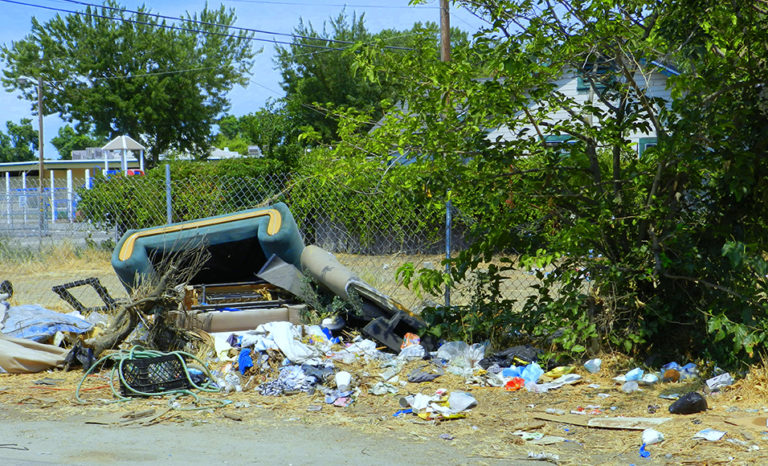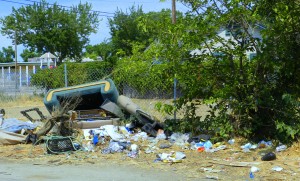

Ask any chief of police. If he’s honest with you, he’ll tell you most violent crime occurs in poor neighborhoods. He will NOT tell you that poor people are criminals any more than rich people. However, violent criminals tend to live in poor neighborhoods for economic reasons. Criminals may become violent when they think they have nothing to lose. Lacking the funds to buy mobility, many criminals tend to commit crimes close to home.
This writer was told by a public official that the City of Sunnyvale has a low violent crime rate. The low crime rate can be attributed to the fact that the locus of poverty is in east San Jose, about 15 miles from Sunnyvale. Fifteen miles is a long distance for poor people to travel.
Easy Way to Dump Social Problems
For the past 40 years, the Bay Area has systematically moved lower income families out of the area, either by deliberate or inadvertent actions. Social policies and programs have the net effect of forcing economically disadvantaged people to the Central Valley. While some public housing has been built in the Bay Area, nowhere near enough has been constructed. Therefore, higher rents have forced large numbers of financially challenged people out to where rents are lower.
During my 26 years with the Modesto office of the Social Security Administration, numerous Bay Area transplants told me that they were forced out of San Jose and other parts of the Bay Area by rising rents. Home building was inadequate. Rather than choose to be homeless, they moved to the Central Valley, where there’s a constant surplus of housing stock thanks to public policy decisions to subsidize housing projects. The housing subsidies have had the net effect of making the Valley attractive to low income citizens.
I also interviewed numerous disabled people, including individuals with mental illness. I learned that Santa Clara County was giving money to disabled people to take a one way bus ride to Modesto. They were promised that someone in Modesto would provide assistance. Employees at the Modesto Social Security office and other public agencies made referrals to the appropriate local public agency.
Modesto’s low rents and public assistance enabled the economically disadvantaged to stay here. Some of those with mental illness became street people in Modesto. Other Valley towns may report similar histories.
A Heinous Example
On one occasion, an elderly man who had completely lost his memory was shipped to Modesto by bus from Santa Clara County. When he got off the bus, he had no idea where he was or what to do and could not even remember his name.
When he was found by the local authorities, he was referred to a Stanislaus County social worker who helped the man get the medical attention he needed. Then the social worker took him to the Social Security office to help him get benefits he was legally entitled to receive.
Through the cooperative effort of multiple public agencies, long lost relatives of the man were located and they gladly provided a home for him. The man had not needed to be homeless because relatives had been looking for him.
Santa Clara County officials dumped the man into Stanislaus County instead of providing him the service he should have received. Santa Clara County is relatively wealthy compared to Stanislaus County. It has greater resources, but chose to do the wrong thing. The elderly man lived for years in misery because he didn’t receive the help he was entitled to.
Social Costs
In 1980, a visitor could drive through Modesto and see very little graffiti, if any. The movie “American Graffiti” depicted an era when the city was relatively small, everyone knew everyone else, and the community was relatively free of violent crime. By the year 2005, over 10,000 current and former gang members were known to live in Stanislaus County. A large percentage of the gang members moved from impoverished neighborhoods in the Bay Area. Crime rates have steadily increased over the years, especially serious crimes.
The recent bank robbery and multiple deaths involving gang members in Stockton reached new highs in violence and sheer horror. The gang problem has continued to worsen as the Bay Area exports its economically disadvantaged citizens. As they come to the Valley, the lack of jobs exerts upward pressure on the unemployment rate, increasing the size of the economically disadvantaged population and associated social problems.
The Bay Area even exports air pollution to the Central Valley, causing the Valley to fail national air quality standards. The air quality problem greatly hinders economic growth in the Valley.
Solutions Exist but the Bay Area Will Not Contribute
The Bay Area has not provided adequate housing for its citizens as job and population growth outstrip housing growth. Today, this state of affairs continues to push the Bay Area’s social problems to the Central Valley.
Additionally, Bay Area communities have cut expenditures for social services deeply despite incredible wealth. Undoubtedly, the cuts have increased the pressure on low income citizens to move into the Central Valley. The Bay Area needs to take care of its own people rather than push them elsewhere.
The City of San Ramon several years ago put in their proposed general plan that they did not need to provide affordable housing because there was plenty in nearby towns like Tracy and Stockton. I see the attitude has not changed.
Great informative article Bruce. On the westside, Patterson is full of these people now. The numbers have gone up dramaticallly since tbe housing bust. There are no jobs for them even if some are employable. The jobs dont exist despite the bragging done by the business park Developers about what a great job they have done.
Comments are closed.